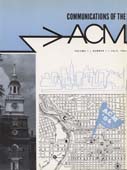July 1964 - Vol. 7 No. 7

Features
In a number of articles published during the past two years, R. A. Brooker and D. Morris (joined by J. S. Rohl in their most recent paper) have presented a very interesting programming system that they have developed for the Ferranti Atlas computer.
The present paper describes some of the major features of their system. It expands on some points that the original authors cover briefly, and treats only very lightly some topics to which they devote considerable space.
The purpose of this paper is purely expository. Except in some very small details, and in some comments, it does not intentionally depart from or add to the material published in the listed references.
In the opinion of the writer, systems of this kind are well worth implementing and will provide useful research tools in the development of languages and techniques. This opinion is true even when such systems turn out to be of limited usefulness in producing “production” compilers, where compiling speed and object code optimization may be considered more important than language flexibility and elegance or generality of system organization.
Programming analysis of variance by sequences of operators and isomorphic mappings
A special operator calculus developed by Hartley in 1956 together with a new mapping scheme has been found to be efficient in programming analysis of variance for multifactor experiments. The operator calculus and the mapping scheme are described in detail.
An automatic loader for subroutine nests
A method for automatic loading of library subroutines, which can be adapted to operate in conjunction with any conventional two-pass assembler is described. The method is specifically designed to cope with a nested library structure.
Talk—a high-level source language debugging technique with real-time data extraction: 26
TALK, meaning Take A LooK, is a debugging technique which aids substantially in debugging complex real-time programming systems by interrupting the users program at desired points to extract previously specified data. The extracted data is later edited, listing the associated data with its high-level source language identification.
Remark on further generalization of ALGOL
The generalized ALGOL described by Nilalus Wirth [1] is in my opinion a major step forward toward the “next” programming language. In this remark I intend to introduce further generalizations which will make the language still more useful.
Characteristics of the FORTRAN CEP language
The FORTRAN CEP languages differs from FORTRAN II mainly because: (1) it extends the variety of the modes for real quantities; (2) it allows suitable mixtures, in an input/output list or in an expression, of quantities that occur under different modes; (3) it makes it possible to address a greater number of input/output equipment; and (4) it removes the restrictions on the complexity of the list of quantities to be transmitted between the magnetic core memory and the drum or the magnetic tape units.
An automated data system analysis technique is described. The technique is designed to alleviate some of the principal problems that beset current analysis—large data workloads, long span of time between project inception and system operational date, the lack of explicit directions for conducting data system analysis and using the results, and the lack of a technique to control data system changes throughout its lifetime. The analysis is geared to determining workload, relationships and storage characteristics of documents in the information network automatically.
Experimental personalized array translator system
A system designed for intimate man-machine interaction in a general-purpose problem-solving environment is experimentally operational. The system utilizes an array-oriented symbolic source language containing powerful statement types. These include numeric, Boolean, relational and selection operators on operands which can be entire arrays. The system also permits simple specification of test and argument arrays in single statements.
The completely symbolic operating system includes display and entry of program and data. Sequence control is aided by an interrupt switch which allows the user to interact with the program during execution. In addition to normal stored program sequencing, the system provides trace options and the ability to enter any statement for immediate execution.
Present implementation of the system is with an interpretive translator on an IBM 1620 computer.
Theoretical considerations in information retrieval systems
A method for automatic loading of library subroutines, which can be adapted to operate in conjunction with any conventional two-pass assembler is described. The method is specifically designed to cope with a nested library structure.
A note on starting the Newton-Raphson method
Determination of a suitable initial estimate for a root of an equation ƒ(x) = 0 by means of computing the roots of a sequence of related equations is described.
Techniques for the simulation of computer logic
A special operator calculus developed by Hartley in 1956 together with a new mapping scheme has been found to be efficient in programming analysis of variance for multifactor experiments. The operator calculus and the mapping scheme are described in detail.



